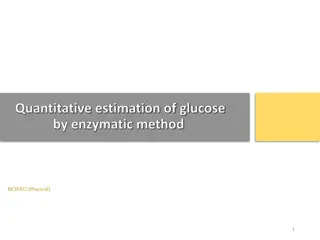Exploring Dialysis Tubing Permeability: Glucose, Starch, and Iodine Experiment
This experiment investigates the permeability of dialysis tubing to glucose, starch, and iodine. By observing color changes and conducting tests, the study demonstrates the selective movement of molecules across the membrane, highlighting the concept of selective permeability in cells.
Download Presentation

Please find below an Image/Link to download the presentation.
The content on the website is provided AS IS for your information and personal use only. It may not be sold, licensed, or shared on other websites without obtaining consent from the author. Download presentation by click this link. If you encounter any issues during the download, it is possible that the publisher has removed the file from their server.
E N D
Presentation Transcript
Diffusion Lab Diffusion Lab The Selective Permeability of Dialysis Tubing
Diffusion Lab Diffusion Lab Purpose of the experiment To test the permeability of dialysis tubing to several different substances (glucose, starch and iodine) Cells need to be able to move materials into and out of the cell and this must occur across the cell membrane. The cell membrane is selectively permeable. This means it can control which molecules can pass through the pores of the cell. Dialysis tubing is an example of a selectively permeable membrane.
Diffusion Lab Diffusion Lab Question Will glucose, starch and iodine pass through the pores of dialysis tubing?
Procedure Procedure 1) Tap water added to beaker and several drops of iodine (potassium iodide) added to the water. This turns the water yellow. 2) Dialysis tubing soaked in water to open it. One end of the bag is clipped to avoid spilling contents into beaker. 3) The other end of the tubing is opened and 4ml of glucose and 3 ml of starch are added to the bag before it is closed. 4) The bag and its content are rinsed with tap water and placed into the beaker along with a stir bar.
Procedure Procedure 5) After 30 minutes the bag is removed and the color of the solution in the bag and the solution in the beaker are recorded. 6) The Benedict test is then performed to test for the presence of sugar in the bag, the beaker and a test tube of water (serves as a control).
Results Results Solution Container Present in Solution Beginning Color Ending Color Color after Benedict s Test Bag Starch and Glucose Colorless Blue/Black Brown Beaker Water and Iodine Yellow Yellow Brown Control Water Colorless Blue Blue The color of the solution in the bag changes to Blue/Black due to the movement of iodine molecules from the beaker solution into the bag. This is possible because iodine is small enough to pass through the selectively permeable membrane of the bag.
Results Results Solution Container Present in Solution Beginning Color Ending Color Color after Benedict s Test Bag Starch and Glucose Colorless Blue/Black Brown Beaker Water and Iodine Yellow Yellow Brown Control Water Colorless Blue Blue The color of the solution in the beaker changes turned brown after the Benedict test due to the movement of glucose out of the bag and into the beaker. This is possible because, like iodine, glucose is small enough to pass through the selectively permeable membrane of the bag.
Results Results Solution Container Present in Solution Beginning Color Ending Color Color after Benedict s Test Bag Starch and Glucose Colorless Blue/Black Brown Beaker Water and Iodine Yellow Yellow Brown Control Water Colorless Blue Blue The color of the solution in the beaker remains yellow the entire time. This indicates that starch does not move from the bag into the beaker because it is too large of a molecule to pass through the selectively permeable membrane.
Conclusions Conclusions Students should now have enough results to write conclusions about how temperature affects diffusion rate (from the lab before this) and how molecule size is a determining factor in a molecule s ability to passively diffuse across a selectively permeable membrane. This experiment should hopefully create a bridge for students to now move into the three basic ways molecules can move across a cell membrane: Passive diffusion Facilitated Diffusion Active Transport























